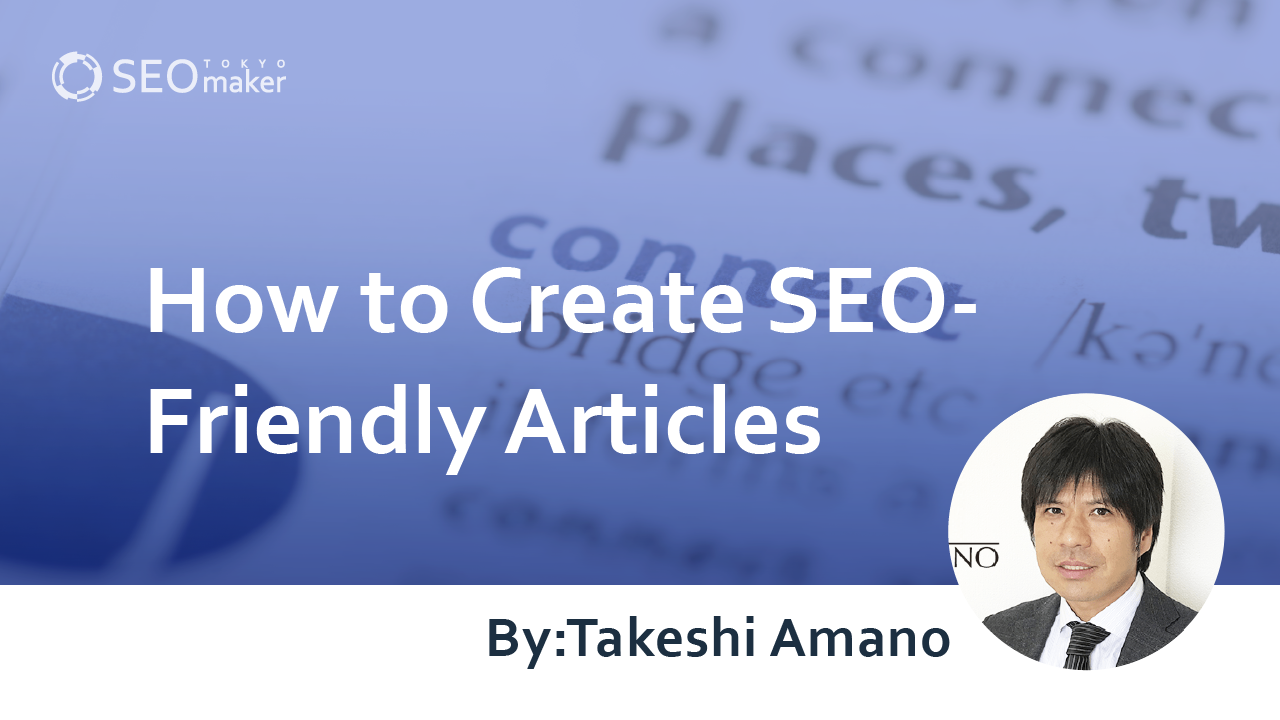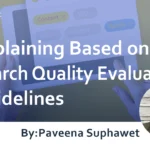How to Create SEO-Friendly Articles : For Beginners

Creating content is crucial in SEO, as emphasized across various media platforms and even by Google, which promotes the saying ‘Content is King.’
Unlike the 2010s, where black hat SEO techniques were prevalent, the 2020s have shifted towards white hat SEO practices. It’s undeniable that content is paramount in boosting SEO through white hat methods. While the tasks have become simpler compared to the 2010s, content creation has become more challenging.
Although SEO copywriting may seem daunting, mastering the key points can lead to remarkable improvements. In this guide, Tokyo SEO Maker will explain how to write SEO articles effectively. Beginners, take note of what SEO writing entails and learn the tips and tricks for writing content with SEO in mind.
What are SEO Articles?
Firstly, let’s discuss the definition. While there may be differences between articles, content, and web pages, for simplicity’s sake, consider them synonymous in the context of the web. Though there are slight distinctions – a web page encompasses headers, footers, sidebars, and main content, while an article refers to the main content within a web page or site – most people use the terms interchangeably.
In essence, consider SEO articles as content tailored to be easily evaluated by search engines.
Keyword Selection
Before creating SEO articles, selecting the right keywords is crucial. Each article must target a primary keyword. Ambiguity or inconsistency in keyword selection will hinder success. While targeting high-volume keywords for the entire site is beneficial, when it comes to SEO articles, even if the monthly search volume is as low as 10, dedicate full effort to crafting content for those specific keywords.
>>Effective Methods for Selecting and Incorporating SEO Keywords! How to Outrank Your Competitors?
Creating Personas and Customer Journey Maps (CJMs)
Despite the plethora of media available on the internet, surprisingly, many overlook the creation of personas and customer journey maps (CJMs).
A persona is a fictional individual (though it can represent a real person) created by imagining the type of person who would visit your site. Without this persona, it’s challenging to define who your content is targeting across the entire site, making it difficult to tailor your articles accordingly.
Some may argue that personas are unnecessary, but this opinion typically comes from either those who underestimate their importance or those who are highly skilled and can create content without them. For those planning to create a website, it’s recommended to set personas and adjust them as needed.
A Customer Journey Map visualizes the process by which customers interact with a service or product. By outlining the stages at which customers encounter the service, gather information, compare, and ultimately make a purchase, while also documenting their thoughts, emotions, and challenges, a Customer Journey Map aids in understanding user behavior and assists in article creation.
Similar to personas, Customer Journey Maps are often overlooked due to the time and effort required for their creation. However, they are crucial elements for media success, so even a simplified version is beneficial. Create one and refine it iteratively to enhance your content.
Structuring SEO Articles
Article structure refers to the title, headings, and the flow of content under each heading. It’s recommended to outline the headings first to avoid the need for extensive revisions later on.
Consider Your Target Audience
Every article has a target audience. While there’s often confusion between personas and target audiences, personas represent fictional individuals, whereas target audiences are real groups.
For example, ’40-year-old males working in IT companies’ are not personas but are part of the target audience. The clarity of your target audience significantly influences your article creation process, including the language level to use, whether to employ technical terms, and the assumed level of prior knowledge.
Considering Needs and Wants
In SEO content, it’s essential to consider search intent, but before that, you need to think about needs and wants.
Needs are the objectives, while wants are the means.
Understanding the purpose behind a search and the methods used greatly impacts article creation.
For instance, if someone has the need to increase revenue online and searches for ‘SEO,’ the want is SEO. However, there are various other methods besides SEO to generate online revenue. Therefore, just because someone searches for ‘SEO’ doesn’t necessarily mean SEO is the solution.
For single-word queries, where the meaning is ambiguous, comprehensive articles are necessary. However, for multi-word queries, the meaning is often clearer, making it easier to identify needs from wants.
The chart above shows the results for the search term ‘vacuum cleaner broken.’ However, the top results are not articles about vacuum cleaners being broken, but rather about possible malfunctions and how to fix them. While the direct answer to ‘vacuum cleaner broken’ might be how to dispose of it, the underlying needs behind this search include ‘it looks broken, what should I do?’ and ‘if it can be easily fixed, I’d prefer to keep using it without having to buy a new one. ‘
Consider the search intent
By thoroughly considering needs and wants, you can identify the search intent. Ultimately, you need to think about what kind of target audience has what needs and wants and searched for them, and whether this article can address those needs and wants.
Once you’ve formed your own opinions here, conducting competitor research can serve as a validation or yield unexpected answers, which can be helpful in article creation.
Competitor Article Research
When creating SEO articles, you have predetermined keywords, so go ahead and search those keywords on Google. Then, go through all the top-ranking articles.
Competing articles that appear at the top are deemed by Google to satisfy search intent. By dissecting the intentions and elements of these articles, you can determine if there are aspects you can incorporate, rewrite, or improve upon in your own article, thus completing the article structure.
How to Write SEO Articles
Once you’ve finalized the article structure, it’s time to start writing. While aligning with search intent is crucial, there are several other points to consider. When enlisting the help of a writer, refer to tips on how to find a good SEO writer.
Title
Always include your keyword in the title. If possible, place the keyword towards the beginning and keep it within 32 characters.
>>Effective Ways to Create SEO Titles
Description
While not directly related to SEO, the description should be around 100 characters and include the keyword 1 to 3 times, succinctly summarizing the article content.
>>Why Set a Meta Description if It Doesn’t Affect SEO?
Headings
Make sure to set headings. The h1 tag can be the same as the title. If possible, include keywords in h2, and include keywords or related terms in h3 and beyond. It’s desirable for the headings to be subdivided enough so that the flow of the article can be understood just by looking at the headings.
>>The Role of Heading Tags in SEO
Word Count
The number of words is not crucial. What matters is whether the necessary and sufficient information for that keyword is included.
By checking competitor articles, you can get an idea of the approximate word count required. However, since articles must always be original, whether they have significantly more or fewer words than competitors is not an issue as long as they contain the necessary information.
>>What is the Relationship Between SEO and Number of Pages? Differences in Index Count and Considerations
Table of Contents
For SEO-focused articles, include a table of contents. While the table of contents itself does not have SEO effects, it appears in search results, potentially improving usability.
If headings are appropriately set, simply looking at the table of contents should help readers understand the flow of the article.
>>The Role of Heading Tags in SEO
Lead Sentence
The lead sentence is located below the title and before the start of the main body (before the table of contents). Users read the title and description before clicking, and then they look at the lead sentence and table of contents to determine if the article is what they need.
When writing the lead sentence, be conscious of what the article contains and what benefits readers will gain from reading it.
>>What is SEO Writing? Essential Writing that Ranks Well on Google
Keyword Density
Keyword density is not relevant to SEO anymore. In the past, it was believed that higher keyword density resulted in better SEO, but that’s no longer the case. Having too many keywords can be flagged as spam and can make the text difficult to read.
>>What is SEO Keyword Difficulty? How SEO Difficulty Varies Significantly by Field
Quotations
It’s not frowned upon to quote from other sites if the information is relevant and necessary. Properly attributing the source and using HTML tags to indicate the quotation is essential. Failure to do so can lead to duplicated content issues.
Videos
Embedding videos can increase dwell time and enhance user understanding, potentially boosting SEO. Utilizing videos can often have a positive impact, so if you have them available, consider using them actively.
Images
Images are crucial for SEO content. Having a catchy image can be beneficial for social media sharing, and including images in articles can improve both SEO and usability.
However, when adding images, it’s important to optimize them by reducing file size, using descriptive filenames, conveying image content to search engines with alt attributes, and specifying sizes to improve Core Web Vitals.
Some media platforms suggest inserting one free image per 1000 to 2000 words. While free images may not directly impact SEO, they can enhance usability, potentially leading to increased readability and thus longer dwell times.
Internal Links
While crafting excellent SEO articles is important, considering SEO for the entire site is equally crucial. It’s essential for published articles to be accessible through internal links, but linking from published articles to related ones is also vital for site navigation.
When adding internal links, pay attention to anchor text (keeping it as the title is fine), and it’s recommended to regularly check for broken links, especially during URL changes or site renovations.
What are Internal Links? Key Points for Strengthening SEO with Internal Links
Outbound Links
While receiving backlinks from external sites (inbound links) has significant SEO benefits, linking from your own site to other relevant sites also carries SEO advantages.
Some may misunderstand that linking to other sites negatively impacts their own site’s evaluation, as the site’s evaluation seems to transfer to the linked site. However, linking to useful information for users is always beneficial.
Ideally, you’d want to keep users within your own site, but it’s acceptable to actively link to external sources like government statistics or research institute findings when necessary information is unavailable on your site.
Comprehensiveness
SEO articles should cover information in a MECE (Mutually Exclusive, Collectively Exhaustive) manner. MECE means ensuring no omissions or duplications of essential information for users and avoiding repetition, which could lead to similar pages.
Multi-word keywords often clarify search intent, making it easier to create definitive answers in articles. However, for single-word queries, more cautious content creation is necessary as the intent may not be as clear.
Uniqueness (Originality)
Even if all other aspects are in place, it’s often challenging to rank higher without uniqueness in your articles. This is because even if you think you’ve written something original, it could still end up being a compilation of other companies’ articles.
Methods to introduce uniqueness vary greatly depending on the field. Sharing your company’s statistical data or research results can be effective, as well as making your content much clearer than that of other sites or providing specific examples.
In specialized fields, differing opinions among experts can enhance uniqueness when effectively incorporated into articles.
Crafting Readable Articles
Many people believe they can’t write articles even if they understand how to.
However, for SEO articles, Google doesn’t judge based on writing skills. Instead, it delves deep into whether the content benefits users.
Even with mediocre writing, if there’s enthusiasm and consideration for users, the intention should naturally shine through. Moreover, the beauty of SEO articles is that they’re easily editable and rewriteable. If something’s missing after publication, you can simply make adjustments later.
Regardless, without articles, there’s no ranking. So, start by considering the following
- Begin with the conclusion
- Use proper line breaks
- Open kanji
- Avoid using technical jargon
- Steer clear of complicated expressions
- Use large, readable fonts
- Include images moderately
Starting with the Conclusion
This might resonate with writers familiar with the PREP method: Point, Reason, Example, Point. Writing in this order speeds up comprehension. Even if you think you’re putting effort into writing an article, users often don’t read as much as expected, especially those who only want the searched answer. By presenting the conclusion at the beginning, users are satisfied, and those interested will continue reading. While some argue that placing the conclusion at the beginning might lead to premature satisfaction and subsequent exit, in many cases, it yields better results. In fact, some media even consider including the answer in the lead paragraph as a prerequisite.
Proper Line Breaks
Especially in academic texts, there’s often a lack of line breaks, with thousands of characters within a single paragraph, making it difficult to read. Legal judgments are good examples of this.
Generally, more line breaks make text easier to read, and it’s often better to use them appropriately. Adjusting line spacing alone can significantly enhance readability for the same reason.
However, too many line breaks can make the text resemble a personal blog or diary entry, which can undermine credibility. The width of the screen varies between computers and mobile devices, but it’s recommended to insert line breaks so that paragraphs consist of 2 to 3 lines when viewed on a computer.
Opening Kanji
Using hiragana instead of kanji, known as “opening” kanji, is an industry term. Conversely, using kanji is referred to as “closing.”
For instance, it’s generally recommended to use “ください” instead of “下さい,” “~など” instead of “~等,” and “ただし” instead of “但し.”
Whether it’s better to use “opening” or “closing” kanji depends largely on the preferences of the media, but establishing unified rules can prevent confusion later on.
Avoiding Technical Jargon
Depending on the target audience, it’s said that SEO writing should be understandable to fifth graders (around 10 years old). This means breaking down complex topics into simpler terms. Therefore, it’s necessary to avoid technical jargon or provide explanations if necessary.
However, if the media is geared towards professionals, using technical jargon might actually enhance understanding, so it depends on the media’s preferences.
Avoiding Complicated Expressions
Generally, prioritizing clarity is key, so avoiding convoluted expressions like double negatives or complex phrases unknown to the average person often leads to better comprehension.
For example: “Not that there isn’t any ~~” → “It’s possible that ~~” “The misosazai playing on the fence” → “A frog in a well
Make the Font Larger and More Readable
Fonts play a crucial role in providing users with easily readable articles. Simply changing the font can significantly alter the image and readability.
If there’s no particular reason, using the default font style is fine, but if you prefer serif fonts, always visually check to ensure readability.
A font size of 16px is considered readable, and readability can vary greatly depending on the line spacing.
For emphasis, consider adding background colors or underlines (but be careful not to make them look like links) to clearly differentiate from other text.
Include Images Moderately
While text alone is fine for search engines, it can be challenging for users to read. It’s necessary to insert images at regular intervals or use tables and bullet points effectively to aid comprehension.
Summary
In this article, we’ve shared the expertise of Tokyo SEO Maker, known for strong SEO-focused content. Simply writing articles without purpose won’t get you to the top of search results. Continuous research on content is essential. However, to rank highly in SEO, you need both strong content and strong (high-quality) external links.
















